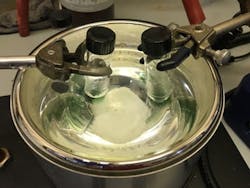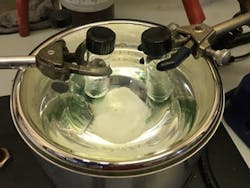Copper Catalyst Cracks C-H Bonds
Researchers at Southern Methodist University (SMU), Dallas, and The Johns Hopkins University, Baltimore, have discovered a way to break the tough carbon-hydrogen molecular (C-H) bond. The method, the researches say, constitutes a first step in developing cheap, environmentally sustainable, and efficient approaches that could replace traditional oxidation processes.
Isaac Garcia-Bosch, assistant professor in the Department of Chemistry at SMU, and chemist Maxime A. Siegler, director of the X-ray Crystallography Facility at Johns Hopkins, used copper catalysts in combination with a nitrogen-based ligand and hydrogen peroxide to convert C-H bonds to C-O bonds.
“We take inspiration of the metalloenzymes found in nature that are able to carry out the oxidation of very challenging substrates (such as methane) under very mild conditions (room temperatures, 1 atmosphere). These enzymes have environmentally benign metals in their active center (like Mn, Fe and Cu). What we do …. is try to emulate the active center of these enzymes by designing simple low-weight metal catalysts that can carry out similar organic transformations outside the biological environment. Our goal is to develop synthetic methods to functionalize organic molecules based on cheap and clean reagents like Cu and O2 or H2O2,” explains Garcia-Bosch.
Figure 1. Upon mixing the reactants (copper, ligand, hydrogen peroxide, and carbon-hydrogen substrate), the colorless solution turns green-blue, indicating that an oxidative process is occurring. Source: SMU
“This is a very important discovery because it’s the first time it’s been proven that Cu can carry out this kind of oxidation outside of nature in an efficient way,” Garcia-Bosch adds. “…Cu is relatively cheap compared to other metals such as palladium, gold or silver, and hydrogen peroxide is readily available, relatively cheap and very clean. One of the byproducts of oxidations with hydrogen peroxide is water, which is the cleanest waste product you could have.”
An article in Angewandte Chemie International provides more details on the project.
“We tested this catalytic system for different substrates and we saw that it’s not very selective. That’s a problem,” admits Garcia-Bosch. “If we have molecules that have many different C-H bonds, then it’s going to oxidize all of them in a non-selective manner.”
“We are now developing a system … to selectively oxidize C-H bonds using Cu and green oxidants (like O2 and H2O2) under very mild conditions (room temperature). We found that the system is not catalytic (stoichiometric amounts of Cu are required) but we are able to hydroxylate C-H positions that are very difficult to functionalize using other oxidative methods. We hope that soon, we will be able to develop Cu complexes able to carry out similar selective oxidations under catalytic amounts of Cu.”
“We would also like to carry these oxidative transformations under smaller amounts of oxidant (close to 1 equiv.) and lower catalyst loadings (lower than our current 1%),” he adds.
“The fact that our best copper catalysts don’t generate over-oxidation products (like carboxylic acids) helps to explain their excellent catalytic performance, in combination with their robustness,” believes Garcia-Bosch.
Producing the catalyst on a larger scale is fairly straightforward, says Garcia-Bosch. “However, I should point out that Fenton oxidations at large scale might be dangerous and should be carried out with caution,” he warns.
Garcia-Bosch welcomes inputs from people in industry. “We would like to know more about their ideas on this subject,” he says. “I think tackling these problems from different perspectives and the collaboration between the different agents (i.e., chemical industry and academia) is critical to develop catalytic processes that are economically viable but at the same time sustainable.”

